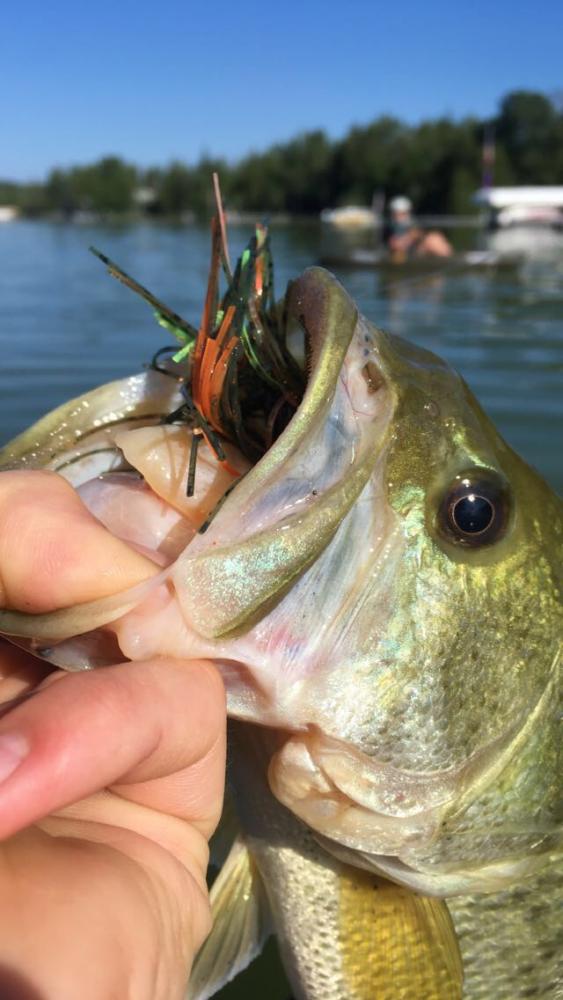Hooked on Bass
Fishing for more than just the prize
Owen Murray ’18 holds a bass he caught during a fishing expedition. The catch and release hobby requires no knowledge or sophisticated equipment, but can be helpful.
Fishing may conjure images of an older man holding a pole on a bucket for hours, but the sport of bass fishing is captivating America’s youth with its aspects of competition, appreciation for nature and the outdoors, excitement and stewardship.
Fishing for bass can be anything from a few friends getting together on a weekend and using lures to catch bass from the bank, to a highly competitive tournament with 50 bass boats set out to catch the biggest bass — and cash a check by doing so.
“Fishing different spots and working all day to have a bass crush your lure is so exciting,” Marco Jacimovic, a sophomore at University High School, said.
Bass fishing is a versatile sport, but most bass anglers share common practices.
“A true bass fisherman is always using artificial lures,” professional bass fisherman and fishing guide Mark Lassagne said.
Bass are targeted by working artificial baits on top of the water, sub-surface in five feet of water, or at the bottom in 20 feet of water, depending on where bass are in a body of water.
“My favorite technique is topwater frog fishing, where I throw a lure that looks like a frog on top of the water, tricking bass into jumping out of the water to eat it,” Jacimovic said. “The adrenaline rush you get from those blowups is like no other.”
Bass caught are then released to keep bass fishing a sustainable sport. Even in tournaments where bass are weighed on land at the end, bass are kept alive in aerated tanks, called livewells, that all boats must have to compete.
“When I bass fish I do it for the sport, I don’t do it to eat the fish,” Dennis O’Donnell ’20 said.
“Bass” refers to the three types of freshwater fish that look similar targeted by anglers. All three bass are targeted using similar lures that provoke or trick bass into striking.
Largemouth bass, the most common and versatile, live in small, dirty ponds, large clear lakes and rivers — and anything in between. Largemouth are famous for reaching full growth potential in California, Texas and Florida. An average adult largemouth is about two pounds, although they have been caught up to 20 pounds in California.
Smallmouth bass, known as “smallies,” are more aggressive than largemouth, and they thrive in colder rivers and big clear water lakes. They average at one to two pounds, and the world record is around 11 pounds.
The elusive spotted bass dominate big lakes with steep drop-offs in the South. Spotted bass are uncommon in the Bay Area, as San Pablo Reservoir is the only local lake offering fishing for them. Spotted bass are comparable in size to smallmouth.
Fisherman targeting bass must analyze conditions regarding weather and moon phases, bass behavior, and seasonal patterns before selecting a lure and deciding how to fish it.
“Fishing in different times of the year is definitely a whole different game,” Dennis O’Donnell ’20 said. “If you fish in the springtime for bass, you can drop your bait on a bass’ bed, and they’ll possibly take it right away. But if you try it in the winter, when bass are much more lethargic, you have to drop the bait practically right on their head to even get bit.”
“It’s a big puzzle, and it’s really rewarding to figure it out,” Lassagne said.
Learning how to make sense of conditions, moon phases, and fish behavior is intimidating to beginners, as it takes a lot of practice and trial and error.
“The first step is to go out with a friend who is an avid bass angler, who can show them the ropes and put them on some fish,” Lassagne said. “They should probably go out when fishing is pretty good.”
Thanks to the internet, bass fishing resources are available at the fingertips. YouTube, forums, and websites offer platforms where experienced anglers share their knowledge and try to make getting into fishing as easy as possible.
“I watch a lot of bass fishing YouTube, and the channels really help out with providing information and knowledge such as how to rig a certain bait,” Jacimovic said.
While youth are attracted to bass fishing by excitement and the fact that it requires thought and practice, the sport also offers a portal to the outdoors.
“You can go out on the water really early in the morning when all the birds are chirping and the sun is rising and you’re just more aware when you are out there without your phone and with nature,” O’Donnell said.
Bass fishing isn’t the only form of fishing that can link youth to the outdoors, though.
“Over the summer, I fly fished,” Kyle Jasper ’20 said. “It brought me closer to the natural habitat of animals because we were out in the forest.”
Aside from offering access to the outdoors through participating in a sport, bass fishing can be an opportunity to relax and participate in an activity with purpose.
“Life can be stressful, and since I have not been able to play lacrosse due to concussions, I am able to release stress through the sport of bass fishing,” Jacimovic said.
“For me, bass fishing has given me kind of a purpose in life,” Lassagne, who also is the editor of Bass Angler Magazine said. “After I caught my first couple bass, I was hooked. I kind of surrounded my life with bass fishing and built a career out of it, from doing the magazine to guiding.”


